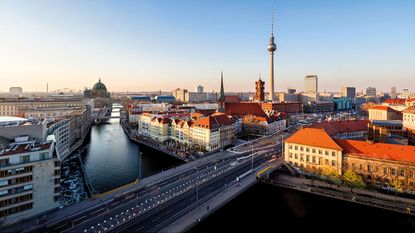The best ways to invest in a resurgent Germany – Europe‘s economic engine
Germany is the most resilient and dynamic economy in a struggling region. Matthew Partridge reviews its strengths, explains how it is rectifying its weaknesses and highlights the best ways to invest.


The 2010s was a dismal decade for Europe. It began with the euro crisis between 2010 and 2015, when sharp recessions and mass unemployment devastated southern Europe; the Covid-19 pandemic has snuffed out the tentative recovery. However, while Italy and Spain languish and France stagnates, Germany, the continent’s powerhouse (it accounts for around 30% of eurozone GDP) proved resilient. Global momentum boosted its export-led economy, helping to ensure that GDP expanded by an average of almost 2% a year between 2009 and 2019, according to the World Bank, compared with an annual 1.5% for the rest of the EU. And Germany looks poised to outperform its neighbours in the next decade too, not least because it is moving beyond its traditional strengths of manufacturing and engineering into new industries.
A big post-Covid-19 bounce
Germany is deemed to have dealt with Covid-19 better than most developed countries. However, the social distancing and lockdowns mean that its economy hasn’t emerged completely unscathed, with the OECD economic organisation of developed countries projecting that its GDP will fall 8% in 2020. A furlough scheme paying 60% of the salary of workers on zero or reduced hours has not been enough to stop unemployment rising to a five-year high of 6.2%.
Still, Germany has several advantages that will ensure that its economy bounces back more quickly than elsewhere, says Andrew Kenningham of Capital Economics. “Before the virus struck, Germany was growing much faster than other countries in Europe.” It is also much less dependent on consumption and tourism, two areas that have been hit particularly badly by the pandemic and are likely to be the last to recover, even after a vaccine is distributed. By contrast, the German manufacturing sector has experienced much less disruption to production and demand.
Subscribe to MoneyWeek
Subscribe to MoneyWeek today and get your first six magazine issues absolutely FREE

Sign up to Money Morning
Don't miss the latest investment and personal finances news, market analysis, plus money-saving tips with our free twice-daily newsletter
Don't miss the latest investment and personal finances news, market analysis, plus money-saving tips with our free twice-daily newsletter
Another reason why Germany should recover relatively quickly is because of its “strong balance sheet”, says Kenningham. Germany is notorious for its puritanical distaste for government spending and debt (it is perhaps not a coincidence that the words for debt and guilt are the same in German). This meant that it went into the crisis with government debt equivalent to around 60% of GDP (compared with 85% for the UK, 98% for France and 138% for Italy).
While public debt has jumped over the last nine months, previous fiscal rectitude reduces the need for dramatic spending cuts and tax rises now and also provides scope for further support of the economy in 2021. The public sector isn’t the only part of the economy that has been thrifty. German consumers are far less inclined to splurge than their Anglo-Saxon counterparts. Household debt in Germany is worth 54% of GDP, compared with 89% in Britain.
Exports power emerging markets
German manufacturing is an important engine of economic growth, says Dr Steve Coulter, head of industrial strategy, skills and sustainability at the Tony Blair Institute for Global Change. This is because manufacturing accounts for a large portion of Germany’s exports, which in turn comprise 50% of GDP (compared with 30% of GDP in the UK). What’s more, many of these exports go to the fast-growing Asian economies, especially China. While the market for cars and machine tools, two of Germany’s biggest exports, “virtually dried up overnight” during the first wave of the pandemic, it has quickly recovered.
There is always the risk that German companies may suffer from any move away from globalisation, especially if “Chinese consumers decide to start switching to domestic brands”, says Coulter. Beijing is keen for domestic companies to shed their low-quality, bargain-basement image and start developing premium products, reducing demand for foreign goods. However, this is a bigger problem for the luxury-goods sector, dominated by the likes of France’s LVMH, than for German manufacturers. The reputation of German companies is based on their ability to “deliver quality goods that are both reliable and reasonably priced”.
German manufacturing excels at producing goods that target the “upper-middle part of the market”, aimed at those who want something more than basic quality, but don’t necessarily want to pay luxury prices. While this segment may be less prestigious than goods at the absolute top end of the market, it still leads to “surprisingly high margins” for firms that can supply the emerging middle class with popular products. Car companies, such as Mercedes and BMW, have been particularly successful in this context.
The Mittelstand: Germany’s backbone
A unique feature of the German economy is the extent to which it relies on the Mittelstand. This segment of the economy comprises a vast number of small and medium-sized firms, but also larger companies with a substantial degree of family ownership or influence that distinguishes them from traditional listed or private companies. According to the Deutsche Börse, the German stock-exchange operator, 58% Germany’s workforce is employed in the Mittelstand and it accounts for around 57% of economic output.
One of the main strengths of these firms is their ability to take a long-term view: they “spend a relatively high amount on research and development”, says Joerg Zeuner, chief economist at Union Investment. This reinvestment means that they can punch above their weight when it comes to staying “on the edge of innovation” and “developing new ideas”. They have remained competitive with global rivals in engineering and manufacturing. At the same time, they have increasingly been moving into new sectors, such as renewables.
Many people argue that smaller firms will always struggle to take advantage of economies of scale “and it’s certainly true that their relative importance to the German economy has slightly declined over the past few decades”, says Coulter. However, they still have several factors in their favour that bode very well for the future. While they compete fiercely between each other when it comes to selling products, “they are very good at organising collective training in order to ensure high labour productivity”. They also have good relations with their local banks, “which are much more forgiving than those in the UK”.
Biotech: a new growth sector
One area that demonstrates the durability of the German model is biotechnology. Germany “has quickly become one of the leading countries in Europe for biotechnology-focused companies”, says Anthony Ginsburg, managing director of GinsGlobal Index Funds. The revenue of the German biotech sector climbed from €3.7bn in 2016 to €4.9bn in 2019. The number of German biotech firms has increased to more than 660, including 23 listed ones, with the workforce rising from 18,000 in 2015 to over 50,000 today.
A key reason for this is the large amount of money, both public and private, invested in research. If you count all universities, colleges and non-academic research laboratories, there are almost 202 research facilities in Germany. The German government is also working hard to make sure that research breakthroughs don’t just stay in the laboratory, but are turned into marketable products. It has created more than 30 biotech hubs to encourage “close collaboration between research institutes, technology parks, regional political players and biotech firms” and they are already starting to make “a big difference”.
Germany’s status as a major player in the biotechnology industry has been cemented by its performance during the Covid-19 crisis. Not only is the vaccine developed by the Mainz firm BioNTech the front runner in the race to be the first to win regulatory approval, but Bosch and Roche have also successfully developed rapid diagnostic tests, with Roche’s antibody test showing a 99.8% accuracy rate. As of last month, there are 97 Covid-19 clinical studies under way in Germany – half of which have reached the trial stage.
The services sector is slowly improving
German firms may dominate engineering and manufacturing, but there is a general consensus that “the service sector is one of the German economy’s weak spots”, says Peter Dixon, senior economist at Commerzbank. This is partly because the focus on manufacturing has meant that the sector has been neglected.
Rules and regulations on anything from opening hours (good luck shopping on a Sunday) to licensing and permits, some of which date back to medieval times, are another problem. Finally, the government’s determination to balance the budget “has also limited the resources available for digital investment”. However, while “additional structural reform” is still required, [Germany’s] performance is often better than is popularly portrayed”. Pressure from the EU on Germany to open up its service sector to competition – by recognising foreign occupational qualifications, for instance, has worked. The number of foreign degrees acknowledged each year has risen to a record 36,000.
Germany’s financial sector also looks set to benefit from Brexit, in the short term at least. Britain is about to lose its “financial services passport”, which allows financial institutions to sell their products across Europe. This arrangement will be replaced with a weaker regime based on “equivalence”. As a result, says Coulter, “many banks that used to employ 10,000 people in London now typically employ 8,000 in London and 2,000 in... Frankfurt. With the EU “trying to make life difficult for London”, whether a deal is agreed or not, banks are likely to remain cautious.
A new workforce
Until recently there was concern that Germany’s future growth would be hampered by an ageing workforce. At present the average German woman has 1.57 children. While this is higher than some European countries (Italy’s fertility rate is just 1.34, for instance), it is still far below the replacement rate of 2.1. As a result, Germany’s population is projected to peak in around five years’ time before falling from 83 million to 75 million by 2060. The ratio of elderly and retired people is also set to increase compared with the working-age population, slowing down growth and raising the burden on public services.
The good news is that this trend is being reversed, or at least postponed, by the increased inflow of workers into Germany. While Angela Merkel’s decision in 2015 to let in large number of refugees on humanitarian grounds may have dominated the political debate, the more important story is the “large amount of economic migration into Germany”, says Union Investment’s Joerg Zeuner. Most of this has been from within the EU, “mostly Eastern Europe, but also some migration from Spain and even Greece”. Immigration has helped bolster the fertility rate from a nadir of 1.24 in 1994.
Whatever the origins of the migrants, “they tend to be younger than the average German, which has helped improve the demographic outlook for Germany”, says Zeuner. They also tend to be relatively skilled and in some cases have even helped found new companies. An excellent example of a company founded by first-and second-generation Turkish immigrants is BioNTech.
A buoyant property market
Germany’s strong growth outlook and more favourable demographics are good news for its property market, which has boomed over the last decade. While prices stagnated and even fell in real terms in the first two decades following the fall of the Berlin Wall, they appreciated by 123% between 2009 and 2019, according to Deutsche Bank.
This has led to a “lot of hand-wringing about property prices”, says Commerzbank’s Peter Dixon. But while there are “justified concerns” about valuations, “the simple fact is that in an environment of low unemployment and zero interest rates, property looks like a good place to be”.
Of course, a future “exogenous shock” could prompt a “correction”. However, the fact that it has “coped well with the biggest shock in living memory” this year suggests it will continue to boom. Even a reduction in bank lending, unlikely at present, won’t be enough by itself to “trigger a major turnaround”. Some ideas for investing in German property – and other promising areas – are in the box below.
What to buy now
The simplest way to buy into the German economy is to invest in an exchange traded fund (ETF) such as the Vanguard Germany All Cap UCITS ETF (LSE: VGER).
This ETF follows the FTSE Germany All Cap index, which aims to mimic the overall German stockmarket. The largest holdings are software company SAP, engineering firm Siemens and financial services company Allianz.
The ten largest holdings account for roughly half the fund. The ongoing charge is only 0.1%, and the fund trades at a price/earnings (p/e) ratio of 15.4, with a dividend yield of 3%.
If you want to invest in smaller German companies, consider the Xtrackers Germany Mittelstand & MidCap UCITS ETF (Germany: XDGM). This focuses on the German market, but excludes the 30 largest companies (these make up the blue-chip DAX index), leaving mostly mid-cap operators such as braking systems specialist Knorr-Bremse, cement manufacturer HeidelbergCement and medical-technology company Siemens Healthineers.
The largest portion of the fund’s holdings are in industrial companies, which account for a quarter of the portfolio. The ongoing charge is 0.4% and the fund trades on a p/e ratio of 15.7.
German biotech BioNTech (Nasdaq: BNTX) made headlines when reports were released earlier this month that its Covid-19 vaccine, which it is developing with pharmaceutical giant Pfizer, could be up to 90% effective in stopping infections, even in elderly patients.
Pfizer believes that it could have up to 50 million doses of the vaccine ready by the end of the year and 1.3 billion available by the end of 2021. It has already pre-sold 230 million doses of the vaccine (mainly to Britain and the US).
In the longer run, BioNTech is developing cancer treatments that use the patient’s immune system. While BioNTech currently loses money, it trades at seven times estimated 2021 earnings.
One of the oldest German biotech companies is Qiagen (Frankfurt: QIA). Although registered for tax purposes in Holland, its operational headquarters is the German city of Hilden. Qiagen mainly focuses on diagnostics and applied testing, including genetic research.
Over the last five years its revenue has been growing by around 7% a year. Among its many products is a portable digital Covid-19 antibody test that can process 30 samples an hour. Qiagen trades at 20 times 2021 earnings.
While Xtrackers FTSE Developed Europe Real Estate UCITS ETF (LSE: XDER) isn’t a pure-play on the German real-estate market, since it invests in real estate in a number of countries, around a third of its assets are in Germany.
It is trading at nine times trailing earnings and has an annual fee of 0.3%. An alternative in this field is Phoenix Spree Deutschland (LSE: PSDL), an investment trust that focuses on a diversified portfolio of 2,571 residential units and 141 commercial units.
These are spread over rental properties in the German capital, where there is a housing shortage. It is currently trading on 15.2 times current earnings, with a yield of 2.1%. It sells for an 18% discount to book value (the sum of its net assets).
Matthew graduated from the University of Durham in 2004; he then gained an MSc, followed by a PhD at the London School of Economics.
He has previously written for a wide range of publications, including the Guardian and the Economist, and also helped to run a newsletter on terrorism. He has spent time at Lehman Brothers, Citigroup and the consultancy Lombard Street Research.
Matthew is the author of Superinvestors: Lessons from the greatest investors in history, published by Harriman House, which has been translated into several languages. His second book, Investing Explained: The Accessible Guide to Building an Investment Portfolio, is published by Kogan Page.
As senior writer, he writes the shares and politics & economics pages, as well as weekly Blowing It and Great Frauds in History columns He also writes a fortnightly reviews page and trading tips, as well as regular cover stories and multi-page investment focus features.
Follow Matthew on Twitter: @DrMatthewPartri
-
 Barclays warns of significant rise in social media investment scams
Barclays warns of significant rise in social media investment scamsInvestment scam victims are losing an average £14k, with 61% of those falling for one over social media. Here's how to spot one and keep your money safe
By Oojal Dhanjal Published
-
 Over a thousand savings accounts now offer inflation-busting rates – how long will they stick around?
Over a thousand savings accounts now offer inflation-busting rates – how long will they stick around?The rate of UK inflation slowed again in March, boosting the opportunity for savers to earn real returns on cash in the bank. But you will need to act fast to secure the best deals.
By Katie Williams Published
-
 The industry at the heart of global technology
The industry at the heart of global technologyThe semiconductor industry powers key trends such as artificial intelligence, says Rupert Hargreaves
By Rupert Hargreaves Published
-
 Three emerging Asian markets to invest in
Three emerging Asian markets to invest inProfessional investor Chetan Sehgal of Templeton Emerging Markets Investment Trust tells us where he’d put his money
By Chetan Sehgal Published
-
 What to consider before investing in small-cap indexes
What to consider before investing in small-cap indexesSmall-cap index trackers show why your choice of benchmark can make a large difference to long-term returns
By Cris Sholto Heaton Published
-
 Why space investments are the way to go for investors
Why space investments are the way to go for investorsSpace investments will change our world beyond recognition, UK investors should take note
By Merryn Somerset Webb Published
-
 Time to tap into Africa’s mobile money boom
Time to tap into Africa’s mobile money boomFavourable demographics have put Africa on the path to growth when it comes to mobile money and digital banking
By Rupert Hargreaves Published
-
 M&S is back in fashion: but how long can this success last?
M&S is back in fashion: but how long can this success last?M&S has exceeded expectations in the past few years, but can it keep up the momentum?
By Rupert Hargreaves Published
-
 The end of China’s boom
The end of China’s boomLike the US, China too got fat on fake money. Now, China's doom is not far away.
By Bill Bonner Published
-
 Magic mushrooms — an investment boom or doom?
Magic mushrooms — an investment boom or doom?Investing in these promising medical developments might see you embark on the trip of a lifetime.
By Bruce Packard Published